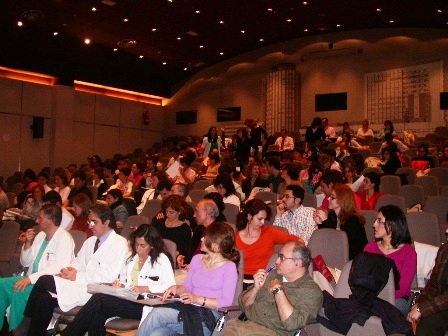| Anestesia en áreas alejadas de quirófano |
Página 8 de 8 Conclusiones
Las sedaciones y anestesias generales fuera del área quirúrgica siempre suponen un reto al tenerse que enfrentar el anestesiólogo, en ocasiones, a complicaciones potencialmente peligrosas, en lugares donde no están familiarizados con el manejo de dichas complicaciones. Las complicaciones más peligrosas son: apnea, obstrucción de la vía aérea, laringoespasmo y parada cardio-respiratoria. La técnica anestésica más recomendable para realizar en lugares alejados del quirófano es aquella que cumpla la regla de las tres “S”: la más Sencilla, que Solucione las demandas anestésicas en todas las ocasiones, y sobre todo, y ante todo, la más segura. La utilización de sevoflurano tanto para las técnicas de sedación consciente, como para la sedación profunda y anestesia general, es una gran alternativa al propofol muy segura, sencilla y eficaz en todo tipo de pacientes pediátricos, sobre todo en áreas alejadas de quirófano, donde los episodios de apnea nos pueden acarrear grandes e innecesarios disgustos.
Biblliografía recomendada:
American Academy of Pediatrics. Commitee on Drugs. Guidelines for Monitoring and Management of Pediatric Patients During and After Sedation For Diagnostic and Therapeutic Procedures. Pediatrics 1992: 89: 1110-1115. Sacchetti A, Schafermeyer R, Gerardi M et al. Pediatric analgesia and sedation. Ann Emerg Med 1994: 23: 237-250. American Academy of Pediatrics: Use of chloral hydrate for sedation in children. Pedíatrics 1993: 92: 471-473. Hannallah RS, Britton JT, Schafer PG et al. Propofol anaesthesia in pediatric ambulatory patients: a comparison with thiopentone and halothane. Can J Anaesth 1994: 41: 12-18. Gray DT, Fyler DC, Walker AM et al: Clinical outcomes and costs of transcatheter as compared with surgical closure of patent ductus arteriosus. N Engl J Med 1993: 329: 1517-152. Rautiainen P, Meretoja OA. Ketamine boluses with continuous low-dose fentanyl for paediatric sedation during diagnostic cardiac catheterization. Paed Anaesth 1993 3: 345-351. Frankville DD, Spear RM, Dyck JB. The dose of propofol required to prevent children from moving during magnetic resonante imaging. Anesthesiology 1993: 79: 953-958. Teh J, Short TG, Wong J et al. Pharmacokinetic interaction between midazolam and propofol: an infusion study. Br J Anaesth 1994: 72: 62-65. Wouters PF, Van Aken H. Magnetie resonance imaging in children: role of the anaesthesiologist. Eur J Anaesthesiol 1997;14: 236-238. Pellier L, Monrigal JP, Le Moine P et al. Use of intravenous ketamine-midazolam association for pain procedures in children with cancer. A prospective study. Paed Anaesth 1999; 9: 61-68. De Roelofse JAV, joubert J, Roelofse PGR. A double-blind randornized comparison of midazolam alone and midazolam combined with ketamine for sedation of pediatric dental patients. J Oral Maxillofac Surg 1996; 54: 838-844 Arendt-Nielsen L, Nielsen J, Petersen-Fehx S et al. Effect of racemic mixture and the (S+)-isomer of ketamine on temporal and spatial summation of pain. Br J Anaesth 1996; 77: 625-631. Himmelseher S, Pfenninger E, Georgieff M. The effects of ketamine-isomers on neuronal injury and regeneration in rat hippocampal neurons. Anesth Analg 1996; 83: 505-512. Tobias JD, Phipps S, Smith B el al. Oral ketamine premedication to alleviate the distress of invasive procedures in pediatric oncology patients. Pediatrics 1992; 90: 537-541 Manuli MA, Davies L. Rectal methohexital for sedation of children during imaging procedures. Am J Roentgenol 1993;160: 577-580. Levati A, Colombo N, Arosio EM et al. Propofol anaesthesia in spontaneously breathing paeditric patients during magnetic resonance imaging. Acta Anaesthesiol Scand 1996; 40: 561-565. Kain ZN, Gaal Dj, Kain TS et al. A first-pass cost analysis of propofol versus barbiturates for children undergoing magnetic resonance imaging. Anesth Analg 1994; 79: 1102-1106. Vangerven M, Van Hemelrijck J, Wouters P et al. Light anaesthesia with propofol for paediatric, MRI. Anaesthesia 1992; 47: 706-707. Kaste SC, Young CW, Holrnes TW, Baker DK. Effect of helical CT on the frequency of sedation in pediatric patients. Am J Roentgenol 1997; 206:95-101. |
||||||||||
| Siguiente > |
|---|




